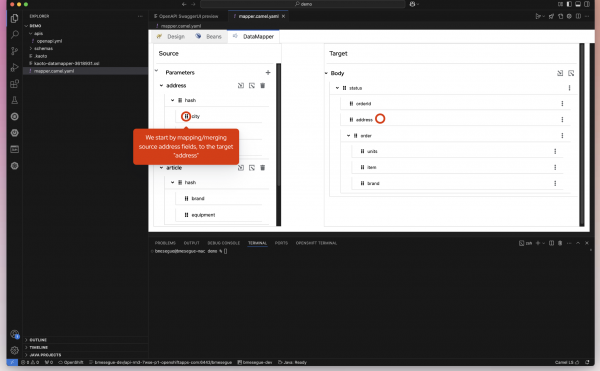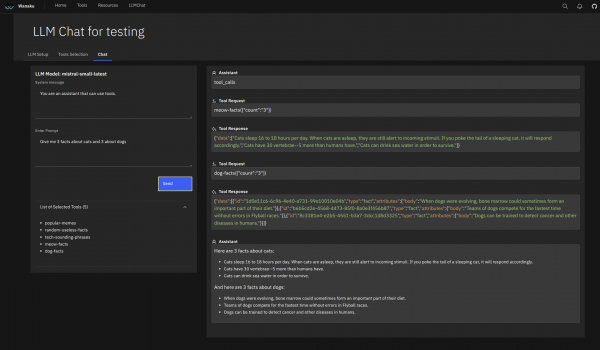Welcome to the Q1’25 edition of Red Hat’s quarterly newsletter all about Apache Camel! This series aims to share all noteworthy Camel goodness over the last quarter so you don’t miss a thing! Be sure to read the previous editions to catch up on all the exciting updates and insights in Q1, Q2, Q3, Q4 of 2024.
Arcade Interactive Kaoto Demo
Explore the fundamentals of Red Hat build of Apache Camel integration using Kaoto through our Interactive tutorial series. The series covers:
- Introduction to Kaoto and its capabilities to create Apache Camel projects
- Installation of the Kaoto VS Code extension
- Creation of initial Camel routes and execution
- Utilization of Kaoto’s visual Data Mapper
- Deployment of Apache Camel projects to OpenShift
- Exploration of AI-enabled integrations using Apache Camel

Each chapter builds upon the previous, providing a comprehensive understanding of Kaoto’s capabilities in designing and implementing Apache Camel projects.
Integration Partner Day in Brno
In March, Red Hat hosted the Integration Partner Day in Brno, drawing 40 partners and customers for a deep dive into modern enterprise integration.
Attendees explored the latest in Apache Camel, Apache Kafka, Kuadrant, OpenShift, and more through expert talks and hands-on demos. A major highlight were partner case studies showcasing real-world modernization journeys such as migrating from Boomi to Apache Camel and building agile integration services on OpenShift. These stories emphasized gradual transformation strategies and practical insights into managing change in complex environments.
Wanaku.ai and MCP
In March, we launched Wanaku, a new community project designed to connect agentic applications with enterprise systems via the Model Context Protocol (MCP). Think of Wanaku as a digital receptionist managing access and routing agents to the right enterprise resources.
At its core, Wanaku links autonomous agents to a routing layer that interfaces with enterprise systems. It leverages Apache Camel integration services to expose parametrizable resource and tool integrations, enabling autonomous interaction for LLMs and agentic applications.
Each tool defines a distinct type of integration. For example, the tool get-information-about-specific-fruit uses an HTTP integration, specified via a URI template like Camel works:
{
"name" : "get-information-about-specific-fruit",
"description" : "Get information about a specific fruit",
"uri" : "https://www.fruityvice.com/api/fruit/{parameter.value('fruit')}",
"type" : "http",
"inputSchema" : {
"type" : "object",
"properties" : {
"fruit" : {
"type" : "string",
"description" : "The fruit to get the information from"
}
},
"required" : [ "fruit" ]
}
}Wanaku v0.0.4 adds support for MCP federation with third-party MCP servers, enabling access to over 4,000 MCP server implementations.
Learn more about Wanaku at wanaku.ai
Articles
Dive into the latest developments within Apache Camel 4 through our curated selection of articles.
Apache Camel AI: Inference via Model Serving #1: TorchServe
Tadayoshi Sato introduces the Camel TorchServe component, explaining how it facilitates running AI model inference on TorchServe within Camel applications. Learn how to integrate PyTorch-trained models into your Camel routes for AI-powered integrations.
Apache Camel AI: Inference via Model Serving #2: TensorFlow Serving
Tadayoshi Sato explores the Camel TensorFlow Serving component, demonstrating how to leverage it for seamless AI model inference using TensorFlow Serving in your Camel applications. Discover how to incorporate TensorFlow-trained models into your Camel integration flows.
Pasquale Congiusti explains the new Camel Observability Services component, which aims to provide a unified way to observe Camel applications by integrating metrics, health checks, and traces. Find out how this component simplifies observability in distributed Camel architectures.
Resolving LangChain4j AI services by name
Alexandre Gallice presents a new feature in Camel Quarkus that allows for resolving LangChain4j AI services by their bean name directly from Camel routes. Discover how this enhancement simplifies the invocation of AI services in Camel Quarkus applications.
Toward better data extraction with structured output
Alexandre Gallice demonstrates the new structured output feature in Camel Quarkus LangChain4j, which leverages JSON schemas to improve the accuracy of data extraction from LLMs. Learn how this feature automatically constrains LLM output for more reliable data integration.
Claus Ibsen, Pasquale Congiusti, Federico Mariani, and Gregor Zurowski detail the new features and improvements included in the Apache Camel 4.11 release, covering areas such as Camel Core, JBang, SQL, Telemetry, Test, Spring Boot, and new components. Read more to discover the latest enhancements to the Camel integration framework.
Demos and Presentations
See Apache Camel 4 in action in the following new demos and presentations:
- Kaoto - Integration Designer for Apache Camel interactive demos
- Getting started with Wanaku - on v0.0.1. Recently we released v0.0.4 significantly simplifying getting started experience:
- download and run cli 'wanaku start local'
- open http://localhost:8080 to access Wanaku Console which includes simple LLMChat specifically designed for quick testing of the tools

Upcoming
You may meet us at the upcoming conferences:
April
- April 16 - Devoxx France
- Zineb Bendhiba and Clement Escoffier will present “Créer des Applications Intelligentes avec Quarkus et LangChain4j”
May
- May 8th - Devoxx UK
- Bruno Meseguer and Markus Eisele will present “Enterprise Integration Is Dead! Long Live AI-Driven Integration with Apache Camel”
- May 19-22 - Red Hat Summit
June
- June 5 - KCD Czech and Slovak
- June 12-14 - DevConf.CZ in Czechia (Brno)
